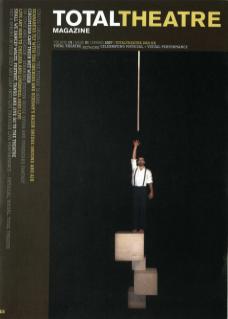Two trips inside two weeks to The Theatre in Chipping Norton, which retains the varied and adventurous programming that I saw at this delightful Cotswold theatre in my formative years.
Breakfast at Audrey’s, written by John Binnie, is a 2005 Fringe Award winning show now on the road. It has a rich and delicately meshed realisation of two narrative strands, the life of Audrey Hepburn and that of Holly, an anorexic Glaswegian teenager. The production is an emotive yet unsentimental exploration of both biography and social issues, allowing the physical images to expose the characters’ psychologies and entrapment, thus ensuring a genuine emotional truth in what so easily could have become a banquet of sentimental angst. This is due in no small part to the decision to allow Holly no voice, prompting us to fill in her dialogue and thoughts for ourselves, and to see her as an individual and not merely as a representative of her condition. Hepburn’s signature tunes are eloquently placed throughout to transport us to the glitz of Hollywood and the pathos of a suffering teenager, while the use of a hooped trapeze, the centrepiece of the set, easily conveys the iconic status and symbolic connotations of Hepburn’s and Holly’s psychology and social position, without imposing upon the narrative. This use of trapeze is used to embody all of the themes of the play, but never feels overused, instead becoming a supporting character to the performers (Philippa Vafadari as Hepburn/Holly and Fiona Bruce as their respective mothers), who shift effortlessly between their roles. Bandazi have tenderly crafted the theatrical and circus elements into an engaging and rewarding show.
Company of Angels specialise in challenging theatre for young people and Virgins, a new play by their resident writer/director John Rettalack, proves to be a cut above the issue-based theatre that was fare in my youthful days. However, whether it is really challenging as a play is less certain. It takes a broad and honest look at the levels of openness about sex and emotions between parents and their progeny, though at times it felt a little cumbersome as it ticked the boxes of the issue, and the dialogue lacked a truthfulness in moments. Fleur Darkin’s choreography, constructed in collaboration with the performers, served to highlight the emotional subtext of the characters’ interactions. Its combination of angular movements against curving bounces gave it a fluid and well-defined purpose, but its status as a transitional element kept it firmly in second place to the text and the narrative. This was a play with dance rather than one emerging out of the fusion of the two art forms. Its charm lay in the moments of humour and delicacy by the actors, notably Peter Machen as the youthful-looking father, who raised the rather pedestrian text above the mundane.

